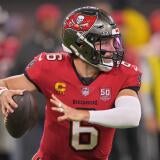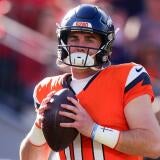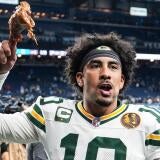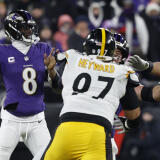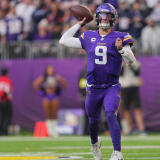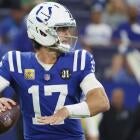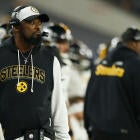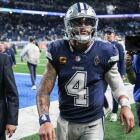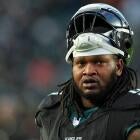Agent's Take: Five NFL Draft blockbuster trades for veterans that need to happen
Here's what it would likely cost to get Richard Sherman, Kirk Cousins or Malcolm Butler

Most trades leading up to or during the NFL Draft (April 27-29) are for current or future draft choices instead of veteran players. Draft picks are the most cost-effective players in the NFL. Their salaries are determined by a rookie wage scale that doesn’t pay productive ones anything close to their true worth.
NBA teams and the Patriots take a more enlightened approach to trading veterans. Signability is more of a primary consideration with moves involving players in a contract year. There are differences in NBA and NFL free agency rules. Compensatory draft picks for lost free agents do not exist in the NBA.
The “Patriot Way” is to get rid of a player a year too early rather than a year too late, whether it’s trading or releasing a player. The Patriots, the reigning Super Bowl champions, didn’t miss a beat last season after jettisoning arguably their best two defensive players from 2015. Chandler Jones was dealt to the Cardinals early last offseason for a 2016 second-round pick (61st overall) and guard Jonathan Cooper, the seventh overall pick in the 2013 draft, since pass rushers are paid a premium. The Patriots weren’t going to pay Jones the going rate for productive pass rushers, which is in the neighborhood of $17 million per year, with over $50 million in guarantees.
Linebacker Jamie Collins turned down an extension of $11 million per year during training camp, which was the Pats’ impetus for dealing him to the Browns as last season’s trading deadline approached. Instead of waiting until next year to receive a third-round compensatory selection at best for Collins leaving in free agency, the Patriots took a third-round compensatory pick in this year’s draft (103rd overall) from the Browns.
The Eagles and Ravens made one of those infrequent trades involving a player last week. Ravens defensive tackle Timmy Jernigan was acquired by the Eagles in a swap of third-round picks. The Eagles dropped down 25 spots to the 99th overall pick while the Ravens moved up to the 74th overall pick. The Ravens re-signing Jernigan, who is entering his contract year, was unlikely after they retained free-agent defensive tackle Brandon Williams with a five-year, $52.5 million deal containing $27.5 million in guarantees.
Here are five veteran players that NFL teams should seriously consider trading in the days leading up or during the NFL Draft using the Patriot Way or adopting an NBA philosophy.
Destination: 49ers
Trade compensation: 2018 first-round pick and 2017 second-round pick (34th overall)
Redskins president Bruce Allen confirmed to The MMQB’s Albert Breer at the NFL’s annual owners meetings in late March that Cousins was offered a five-year extension over the $23,943,600 franchise tag he’s currently scheduled to play under this season. According to Mike Jones of the Washington Post, this is the same $20 million per year offer with “low” guarantees that was made around the time of the NFL combine in late February. The offer is below the average of 2016’s top 15 quarterback deals, which is approximately $21.225 million per year.
Structure is everything with NFL contracts, since the deals aren’t fully guaranteed. Any Redskins offer with less than $40 million fully guaranteed at signing won’t be taken seriously by Cousins’ camp. The five-year, $75 million contract the Redskins gave free-agent cornerback Josh Norman last April with a player-friendly structure had $36.5 million fully guaranteed at signing.
Allen indicated that the Redskins are committed to getting Cousins signed before the July 15 deadline that franchise players have for long-term deals. It’s probably going to take a contract in the same ballpark as the five-year extension Andrew Luck received from the Colts last offseason, which reset the NFL pay scale, to lock up Cousins long-term. Luck’s contract averages $24.594 million per year and contains $87 million in guarantees, of which $47 million was fully guaranteed at signing.

There’s a lot of skepticism about the Redskins ever getting into this territory for Cousins. Waiting is going to make signing Cousins more difficult for the Redskins because Derek Carr, Matt Ryan and Matthew Stafford are in line for offseason extensions from the Raiders, Falcons and Lions that should eclipse $25 million per year.
Cousins would reportedly welcome a reunion with 49ers head coach Kyle Shanahan. The first-time head coach was Cousins’ offensive coordinator with the Redskins during his first two NFL seasons.
The most recent relevant veteran quarterback trade data point is the Eagles receiving a 2017 first-round pick (14th overall) and a conditional 2018 fourth-round pick from the Vikings for Sam Bradford after Teddy Bridgewater went down late last preseason with a gruesome knee injury. A fairer approximation of Cousins’ trade value could be the first-round pick (15th overall) and two third-round picks in the 2008 draft that the Chiefs received from the Vikings for defensive end Jared Allen after he had been given a franchise tag. A swap of 2008 sixth-round picks was also a part of the trade. Above-average starting quarterbacks are generally more valuable than pass rushers, even elite ones. Although an argument can be made that there isn’t any price too steep for a franchise quarterback, the 49ers parting with the second overall pick in the upcoming draft probably wouldn’t be on the table if there were serious trade discussions.
Why the trade won’t happen: The 49ers are in great position to get Cousins for nothing by being patient. The Redskins having two cost-prohibitive options in 2018 to restrict Cousins again makes it likely the quarterback hits the open market next year. Using a transition tag, which would give the Redskins matching rights for an offer sheet signed by another team, would cost $28,732,320. A third franchise tag would be $34,478,784. Additionally, the Redskins would probably want a king’s ransom for Cousins, even though a 2019 third-round compensatory pick, which is at the end of the round, is all they would get if he leaves in free agency next offseason.
Destination: Raiders
Trade compensation: 2017 second-round pick (56th overall), 2018 fifth-round pick and CB David Amerson
Surprisingly, the Seahawks are open to moving the three-time All-Pro. There are conflicting reports about whether a trade was initially Sherman’s idea or Seattle’s idea.
Seattle would be justified in seeking similar compensation as the Jets received shortly before the 2013 draft from the Buccaneers for Darrelle Revis, who was recovering from a torn ACL in his left knee. The Jets got a 2013 first-round pick and a conditional 2014 fourth-round pick. The conditional pick would have become a third-round pick if Revis had remained on Tampa Bay’s roster on the third day of the 2014 league year (March 13). Revis, a couple months shy of his 28th birthday, signed a six-year, $96 million contract as part of the transaction. Sherman, who just turned 29, earned his fourth straight Pro Bowl berth in 2016.
I was involved in a pre-draft trade of a high-caliber veteran cornerback during my agent days. The Dolphins gave us permission to shop three-time Pro Bowl selection Patrick Surtain, who was entering his contract year, in 2005 because our contract demands for an extension were deemed excessive. After the Chiefs expressed interest in Surtain, we started negotiating a new contract for him while the two teams agreed on trade compensation. Surtain, whose 29th birthday was approaching, went for a 2005 second-round pick (46th overall) while 2005 fifth-round picks were also swapped with the Chiefs moving up 24 spots. At the time, Surtain was in the discussion for best NFL cornerback not named Champ Bailey.
Acquiring a veteran player at a need position would lower the draft-choice compensation. That’s where Amerson, who is close to four years younger than Sherman, comes in. The Raiders rewarded him with a four-year, $33 million extension containing $17 million in guarantees last summer after a breakout 2015 campaign in which he was an early-season waiver wire pickup. Opposing quarterbacks completed 55.8 percent of passes (58 of 104 attempts) when targeting Amerson for a 62.7 passer rating, according to Pro Football Focus (PFF). Amerson regressed in 2016. PFF had 64.5 percent of passes (60 of 93 attempts) completed against him for a 101.1 passer rating.
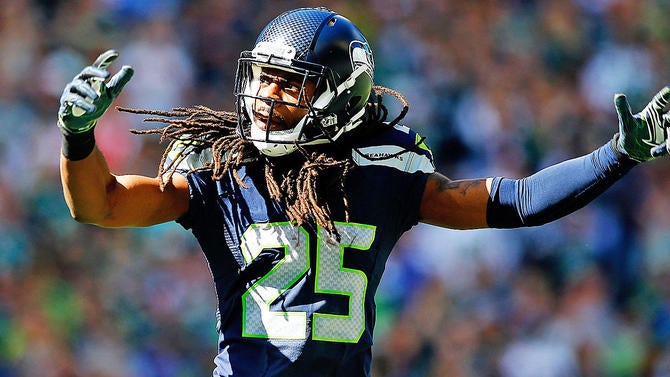
Sherman would help shore up a weak pass defense for a Raiders team expected to be a Super Bowl contender. The Raiders ranked 24th against the pass last season, allowing 257.5 yards per game and tied for 20th with 27 touchdowns given up through the air.
Seattle would pick up $2.231 million of 2017 salary cap room by acquiring Amerson. Sherman’s 2017 cap number is $13.631 million. There would be a $4.4 million cap charge from his $11 million signing bonus with the trade while Seattle would be paying Amerson $7 million in 2017. The Raiders have already paid Amerson a $1.5 million roster bonus that was due March 11. Amerson is under contract through the 2020 season with annual salaries of $6M in 2018, $7.5M in 2019 and $7,880,123 in 2020. His $5.5 million 2018 base salary is guaranteed for injury and becomes fully guarantees Feb. 7.
The remaining two years on Sherman’s contract for $22.431 million are a good value for an elite cornerback. The Raiders would lose $4.431 million of their over $31.1 million of existing cap room by taking on Sherman’s $11.431 million 2017 salary.
Why the trade won’t happen: Cornerback is already a weakness for Seattle with Sherman. Starting cornerback DeShawn Shead tore the ACL in his left knee during a January playoff loss to the Falcons. It remains to be seen whether the real Amerson was the player in 2015 or ‘16.
Destination: Browns
Trade compensation: 2017 second-round pick (52nd overall from Titans) and a swap of 2017 third-round picks (Bengals’ 73rd overall for Browns’ 65th overall)
Most of the public attention has been focused on whether the Patriots will be willing to trade 2014 second-round pick Jimmy Garoppolo, who is entering his contract year. Garoppolo looked like a quality starting quarterback in the six quarters he played while Tom Brady was serving a four-game suspension for Deflategate before spraining the AC joint in his right shoulder.
McCarron, a 2014 fifth-round pick, might be a better fit requiring far less draft capital. Browns head coach Hue Jackson was the Bengals’ offensive coordinator in 2014 and ‘15 so he already knows McCarron’s capabilities. Giving up at least the 12th overall pick in this year’s draft would be a necessity with Garoppolo.
McCarron took over at quarterback down the stretch of the 2015 season after a broken thumb sidelined Andy Dalton. In seven games (three starts), he connected on 79 of 119 passes (66.4 completion percentage) for 854 yards with six touchdowns and two interceptions, which was good for a 97.1 passer rating. McCarron would have a playoff win to his name but for the Bengals’ ill-timed defensive penalties late in a wild-card loss to the Steelers. He didn’t throw any passes in 2016.

McCarron will not be entering the open market like Garoppolo after the season despite being in the same draft class. He didn’t earn a year of service toward free agency in 2014 because he spent most of his rookie season on the non-football injury list with a shoulder injury. McCarron will be a restricted free agent in 2018. Assuming McCarron is given the highest restricted free agent tender, which will be a minimum of $4.106 million, the Bengals would get a first-round pick if they didn’t match another team’s offer sheet for him.
Inexperienced young veteran quarterbacks since the turn of the century typically have gone for second- or third-round picks in trades. In 2007, the Texans acquired restricted free agent Matt Schaub from the Falcons in a sign-and-trade deal where they gave up two second-round picks (2007 and ‘08) and switched 2007 first-round picks. Schaub had only started two games during his three seasons in Atlanta. The Chargers traded Charlie Whitehurst to the Seahawks in 2010 for a 2011 third-round pick. A swap of 2010 second-round picks was also made with the Chargers moving from 60th to 40th. Whitehurst hadn’t thrown any regular-season passes when dealt.
Why the trade won’t happen: There isn’t any urgency for the Bengals to trade McCarron, especially to an in-state division rival. The Bengals control McCarron’s rights next year and could get a 2018 first-round pick in return with an offer sheet that isn’t matched.
Destination: Saints
Trade compensation: 2017 second-round pick (42nd overall) and a conditional 2018 fourth-round pick (becomes third-round pick if Butler is named to Pro Bowl on the original ballot or second round pick if first-team All-Pro)
Butler, a restricted free agent, visited the Saints last month. An offer sheet won’t be signed because the Saints think giving up the 11th overall pick in the upcoming draft is too steep of price to pay to sign Butler. Contract parameters were reportedly discussed in conjunction with the visit.
Logistically, Butler would have to sign his $3.91 million restricted free agent tender before being traded and a long-term deal would be signed in the process. Presumably, the value of Butler’s unrestricted free agent years would be in the same range of $13 million to $14 million per year as the deals recently signed by A.J. Bouye, Stephon Gilmore and Desmond Trufant.
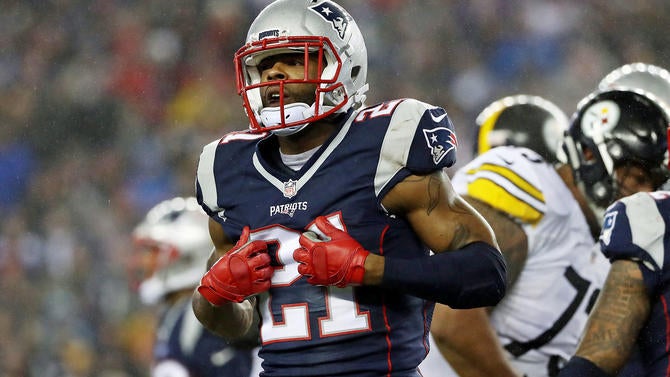
A trade that could be used as an indication of the type of compensation that the Patriots should receive is DeAngelo Hall’s. He was acquired by the Oakland Raiders from the Atlanta Falcons in 2008 for a 2008 second-round pick and a 2009 fifth-round pick. Hall was a two-time Pro Bowl selection when he was traded. Butler’s lone Pro Bowl selection was in 2015.
Why the trade won’t happen: New England would have two new starting cornerbacks in 2016, after Logan Ryan bolted to the Titans in free agency. So much secondary upheaval might not be worth it to the Patriots without getting a first-round pick in return.
Destination: Broncos
Trade compensation: 2017 third-round pick (82nd overall)
A change in scenery might be best for Richardson since the Jets have one too many quality 3-4 defensive ends with Muhammad Wilkerson and Leonard Williams on the roster. The 2013 NFL Defensive Rookie of the Year’s long-term prospects with the Jets took a hit when his defensive linemate Wilkerson signed a five-year, $86 million contract with $53.5 million in overall guarantees last summer.
The Jets shopped the talented but troubled Richardson before last season’s trading deadline. The first-round pick the Jets reportedly were seeking for Richardson is out of the question because of a subpar 2016 season and his well-documented off-field issues. The swap for third-round picks in the Timmy Jernigan trade probably helps define trade compensation for Richardson. Moving Richardson would wipe his $8.069 million fifth-year option salary from the Jets’ books.

Denver reportedly kicked the tires on Richardson before last season’s trade deadline. He would help fill the void created on the defensive line when Malik Jackson left for the Jaguars during free agency in 2016.
Why the trade won’t happen: Richardson could be an expensive one-year rental since he will be an unrestricted free agent in 2018. He’ll also likely view Wilkerson’s deal as his salary floor with a bounce-back year. Taking on a player with significant baggage might be an unnecessary risk for first-time head coach Vance Joseph.












